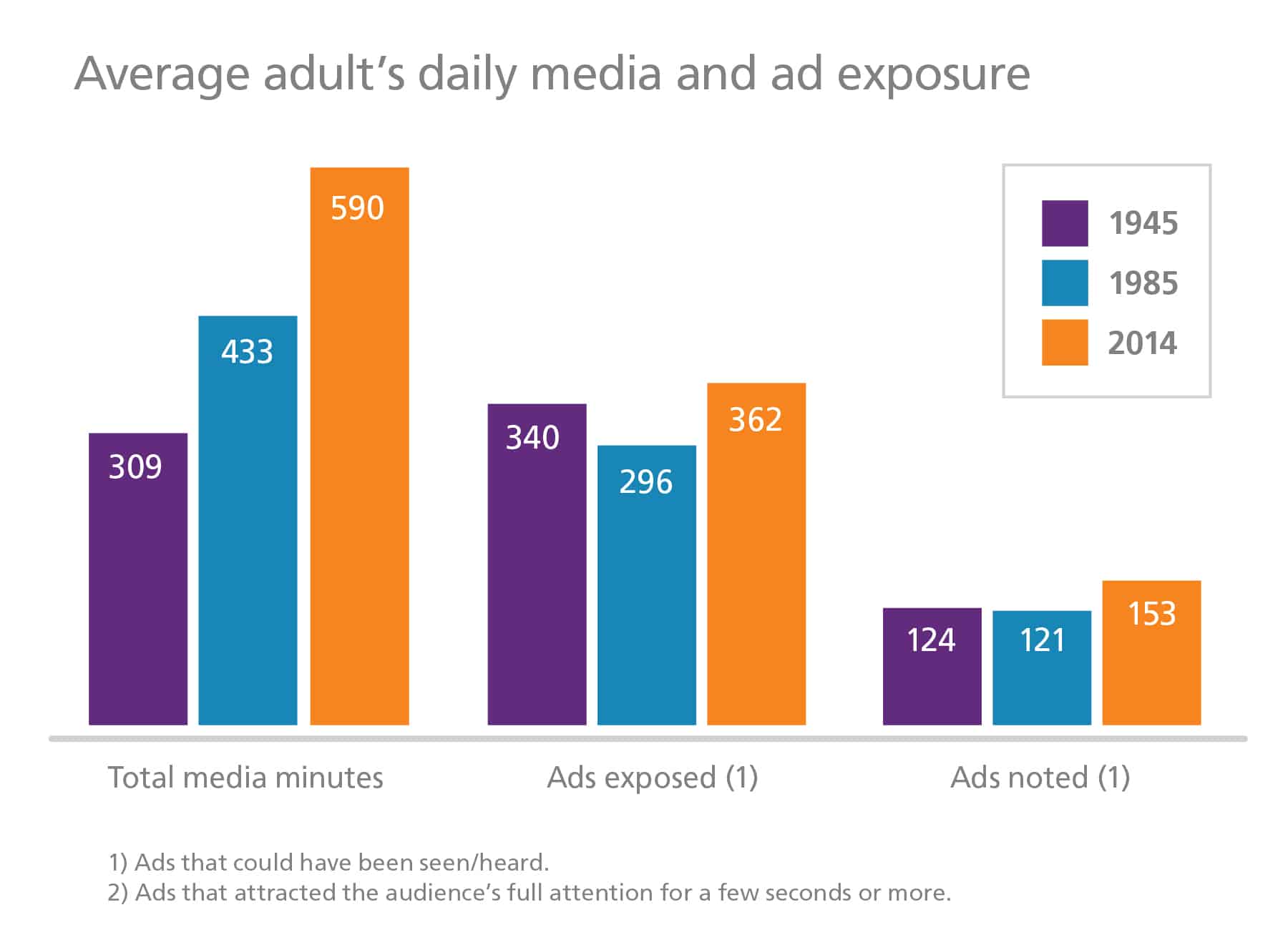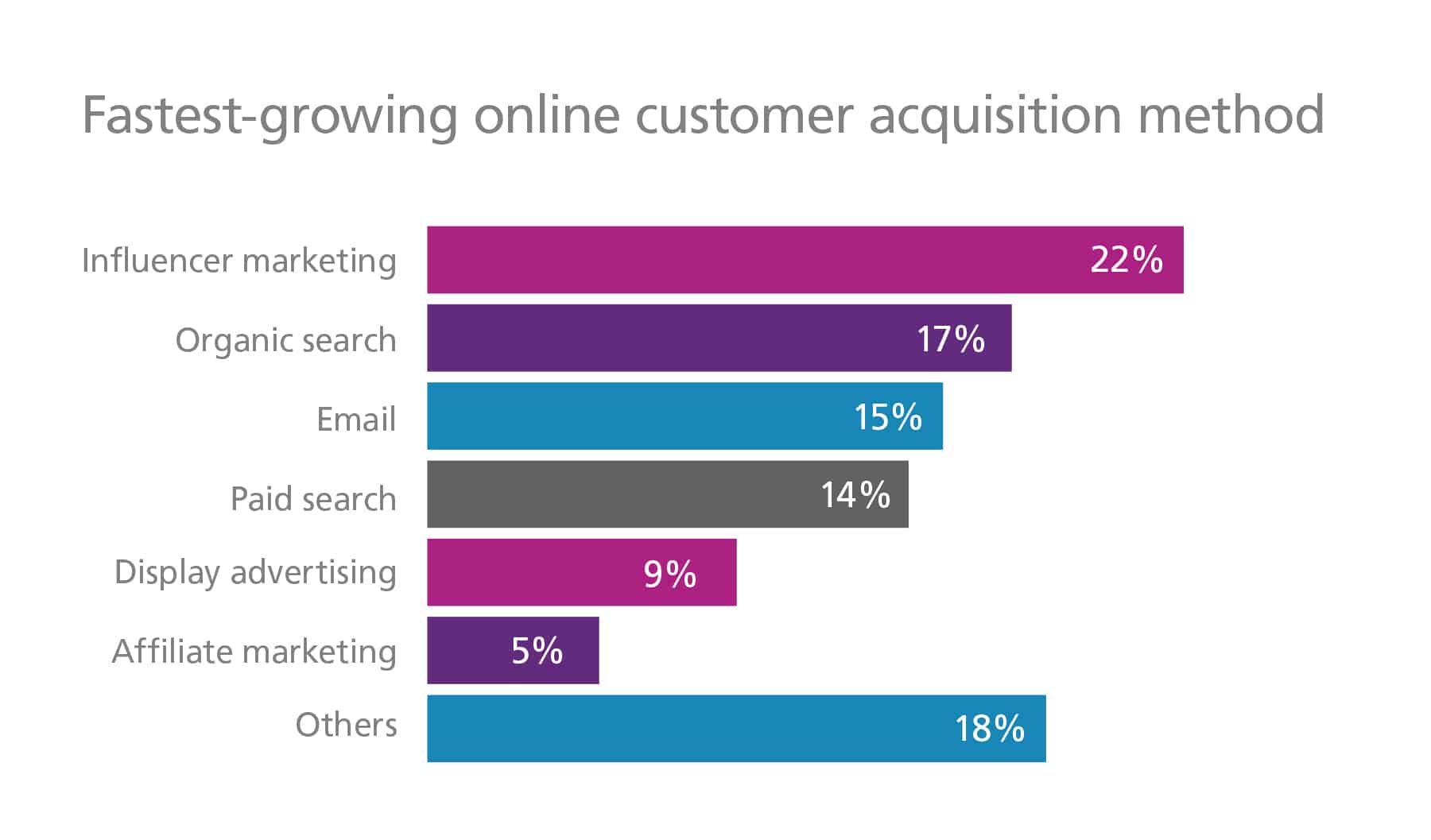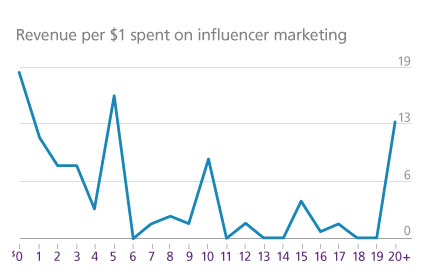“Content shock” propels influencers
With information and resource overload, businesses and consumers are in a state of “content shock.”[8] Figure 1 below shows the average adult’s daily media and advertisement exposure:[9]
Average adult’s daily media and ad exposure
Total media minutes the average adult was exposed to in different years:
- In 1945, 309 minutes
- In 1985, 433 minutes
- In 2014, 590 minutes
Total ads that could have been seen/heard in different years
- In 1945, 340 ads
- In 1985, 296 ads
- In 2014, 362 ads
Total ads that attracted the audience’s full attention for a few seconds or more in different years:
- In 1945, 124 ads
- In 1985, 121 ads
- In 2014, 153 ads

Individuals are exposed to more media today than ever before. However, the ability to capture one’s attention or the ability to engage consumers has not increased to the same degree, as shown by the number of ads noted. Thus, businesses must look beyond traditional marketing and advertising techniques to get their message to consumers. The issue is not getting in front of consumers, but it is getting in the minds of consumers to the extent that they act by purchasing your product or service. That’s why influencer marketing has captured the attention of so many and led to results like those found by Tomoson’s influencer marketing study (Figures 2,3,4):[10]
Fastest-growing online customer acquisition method
- Influencer marking: 22%
- Organic search: 17%
- Email: 15%
- Paid search: 14%
- Display advertising: 9%
- Affiliate marketing: 5%
- Others: 18%

Most cost-effective online customer acquisition method
Influencer marking: 22%
Email: 22%
Organic search: 19%
Paid search: 10%
Display advertising: 10%
Affiliate marketing: 2%
Others: 16%.


Tomoson’s study shows that businesses are not only making $6.50 for every $1 they spend on influencer marketing, making it more cost-effective than other marketing mediums, but that influencer marketing is their fastest-growing online customer acquisition channel. Beyond those statistics, more than half of marketers believe they acquire better customers through influencer marketing, when rating customer acquisition quality for each channel.
Influencer marketing is successful, in part, because it taps into human relationships. Ninety-two percent of consumers rely upon people they know above other sources for referrals.[11] Influencer marketing’s success reaches beyond business-to-consumer (B2C) interactions as well; 84 percent of business-to-business (B2B) buyers start the purchasing process with a referral.[12]
Influencer marketing has caught the attention of marketers and entrepreneurs because it has been shown to cut through the clutter of information overload and deliver results. Now, let’s learn how to bring influencer marketing success to your business.
Influencer marketing success for your business
Like other forms of marketing, one of the first steps of influencer marketing is to determine who your target audience is for a given product, service or brand. While many marketers and entrepreneurs have a solid understanding of their target customer, the next part—determining who your target influencer is—is essential to successful influencer marketing.[13]
Context and relationships to consumers are important when determining who your influencers should be. A young female pop star may have an expansive social media following, but if you’re a medical device company, is that young pop star the best influencer for your brand? No, because influencers have a strong, contextual following and an organic affinity for the brand.[14] The market is saturated with sponsored spokespeople and million-dollar endorsement deals; consumers desire authenticity, so give them that through influencers who make sense—those who don’t have to make their way into a niche but already populate that niche.
Reach is a key component of finding successful influencers as well. How many people does your influencer have the ability to connect with not only for a specific marketing campaign, but in general? You may have a devoted customer who raves about your product or service, but if he or she has little reach, be that through traditional means such as word-of-mouth and especially through social media, then his or her value drastically diminishes as an influencer. Any one customer can discuss his or her purchase or experience at your business, but who are those customers who can discuss his or her purchase with many people in many mediums and have a measurable impact? One study shows that a tweet will, at most, reach 15 percent of a Twitter® user’s followers, with the average hovering closer to 1 to 5 percent.[15] Thus, examining and targeting relevant and engaging influencers is more effective than choosing an influencer merely based off of their number of followers.
Lastly, an influencer should inspire action, resulting in increased awareness, sales and revenue for a given business.[16] Can your influencers drive people to pull out their checkbooks? Can your influencers effortlessly persuade people to pay for your product or service? Don’t confuse reach or audience for true influence. Action is key.
Finding influencers
Finding influencers comes through a number of ways:
- Monitor social media: With the explosion of social media, blogs and other means of digital communication during the last few years, someone somewhere is talking about you, your product, your brand or your industry. Monitor social media to find influencers who fit the context, reach and action-inspiring characteristics you want. Monitoring social media also allows you to delve into niches that you may have not even known specifically existed but are best suited for your brand’s influencer marketing campaign.
- Research hashtags: Hashtags can help determine who is active on social media and actively discussing the product, service or brand you are trying to sell.
- Set search and keyword alerts: Blogs are niche and influential, so finding and establishing relationships with them must be part of your influencer marketing strategy. Internet search alerts and keyword searches can help you find relevant bloggers. Oftentimes, bloggers comment on similar blogs or share other bloggers’ content, so working to understand key players and the web of influencers in your niche can go a long way in determining your most influential followers.
- Identify relevant industry events and conferences: While social media may yield the best results for finding most influencers, a more traditional route of identifying industry conferences and events and checking out the list of speakers and vendors can help you find other influencers. Have you ever noticed that the same people who speak at conferences seem to write guest columns in industry publications? Have you noticed that those who are quoted in news articles are the same people who may be featured as experts in television news stories? If yes, then you’re well on your way to identifying some influencers within your industry.
Page 2 of 4
